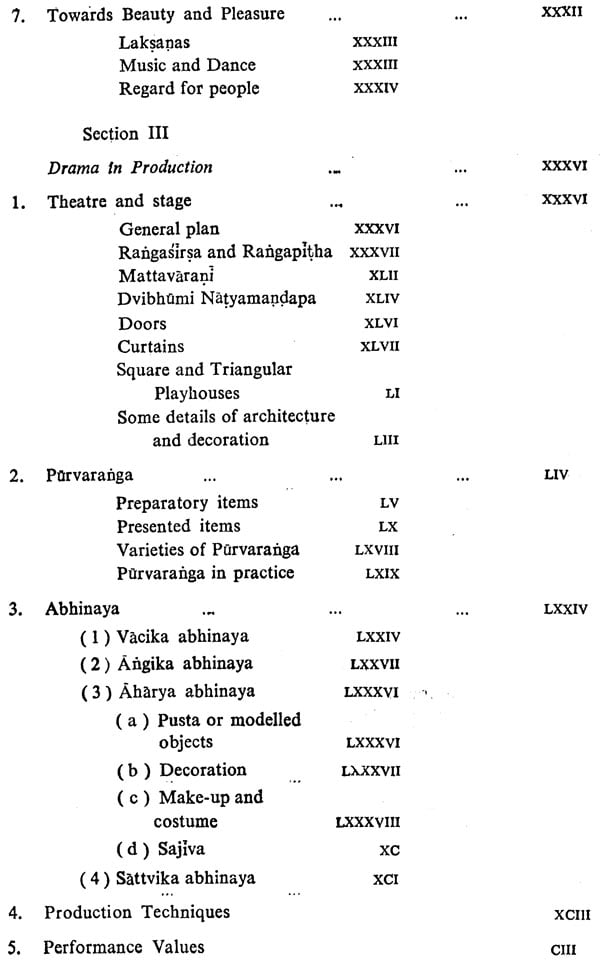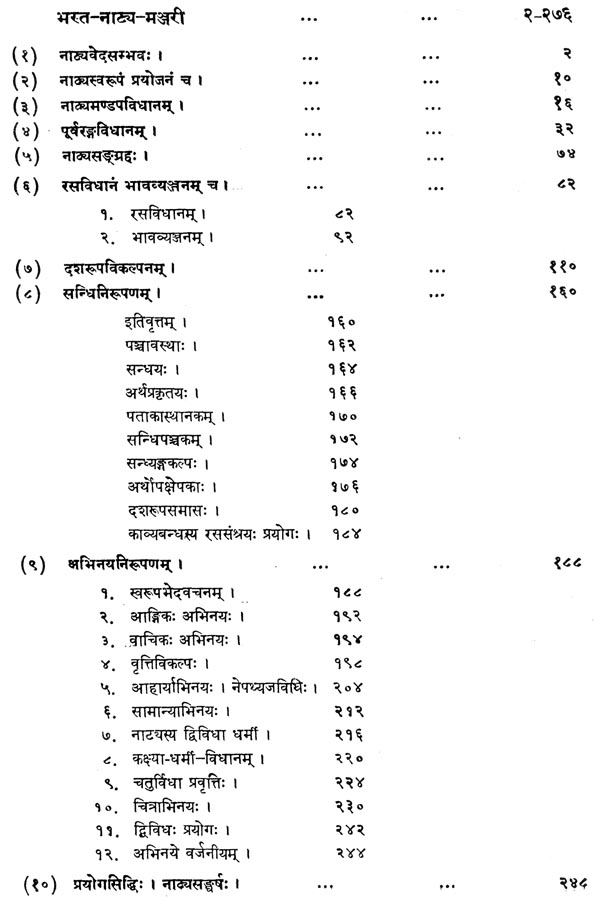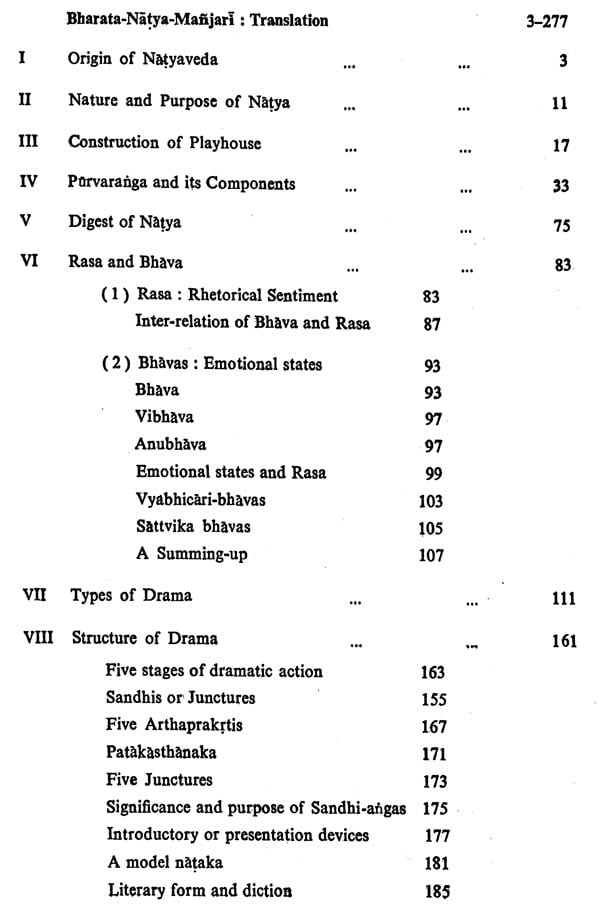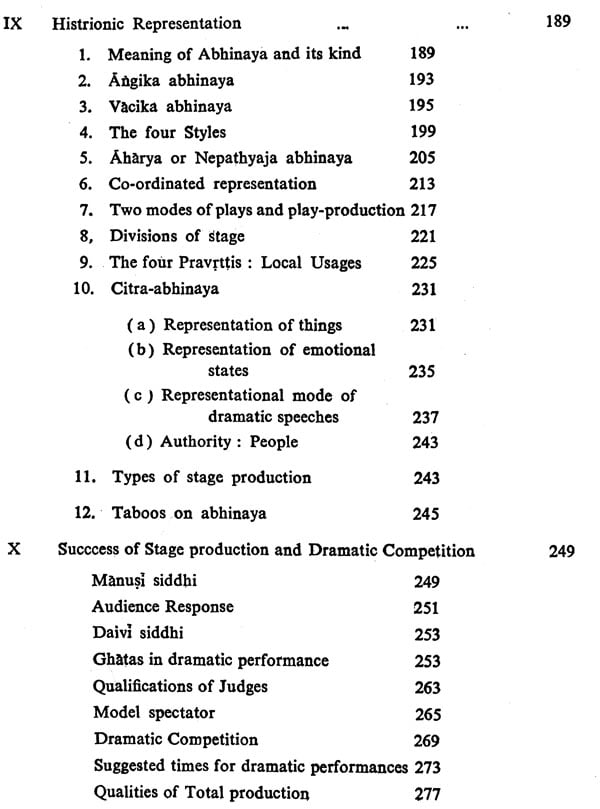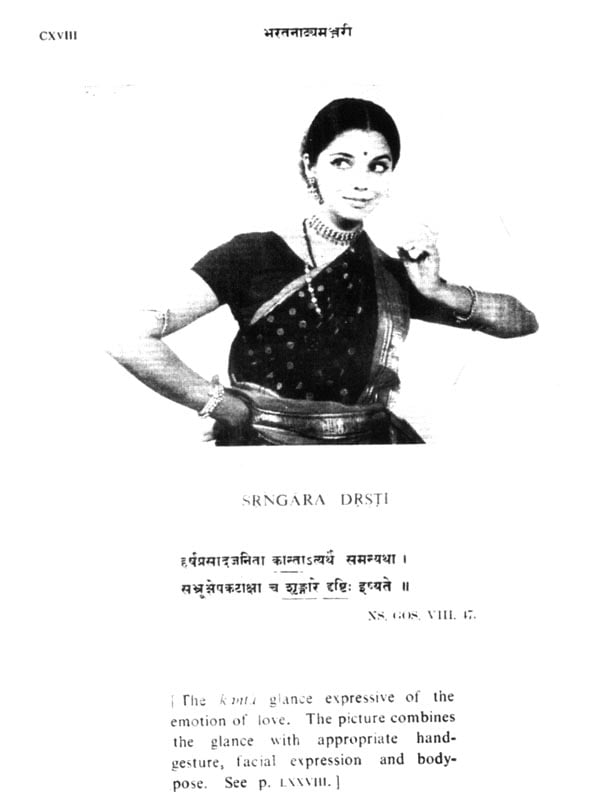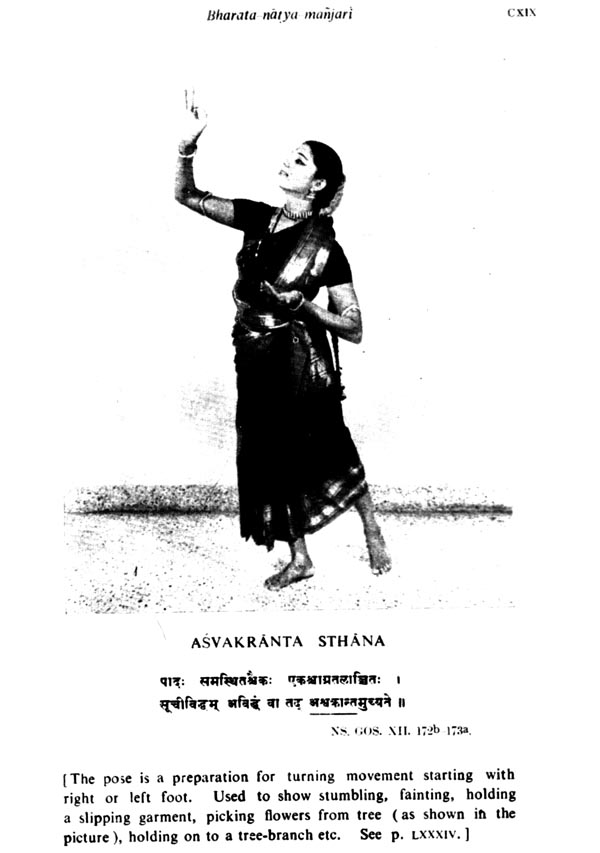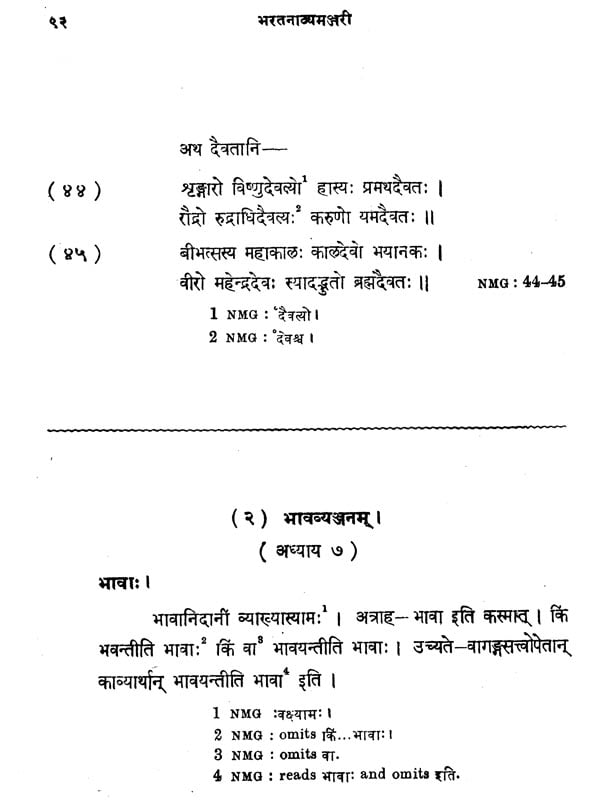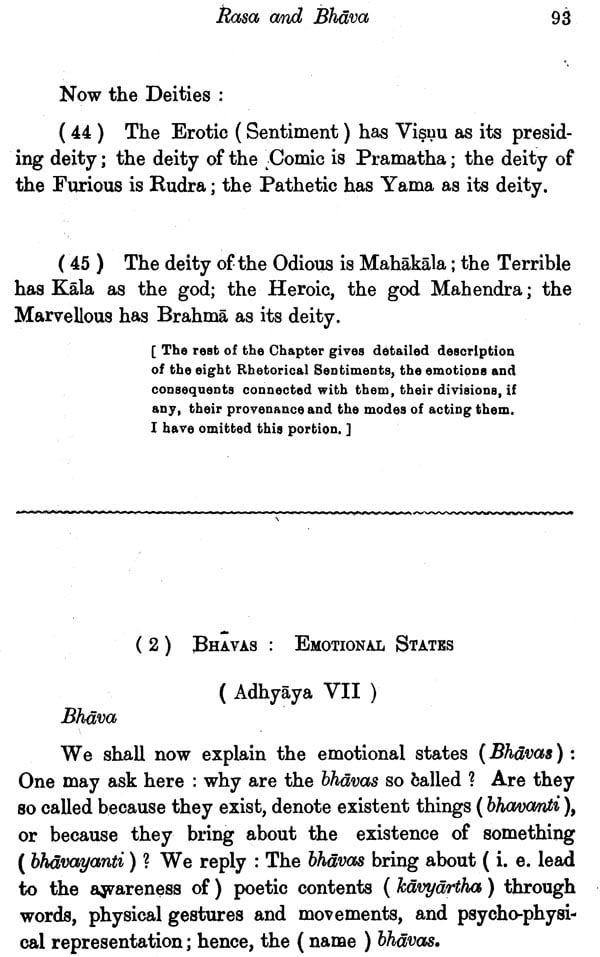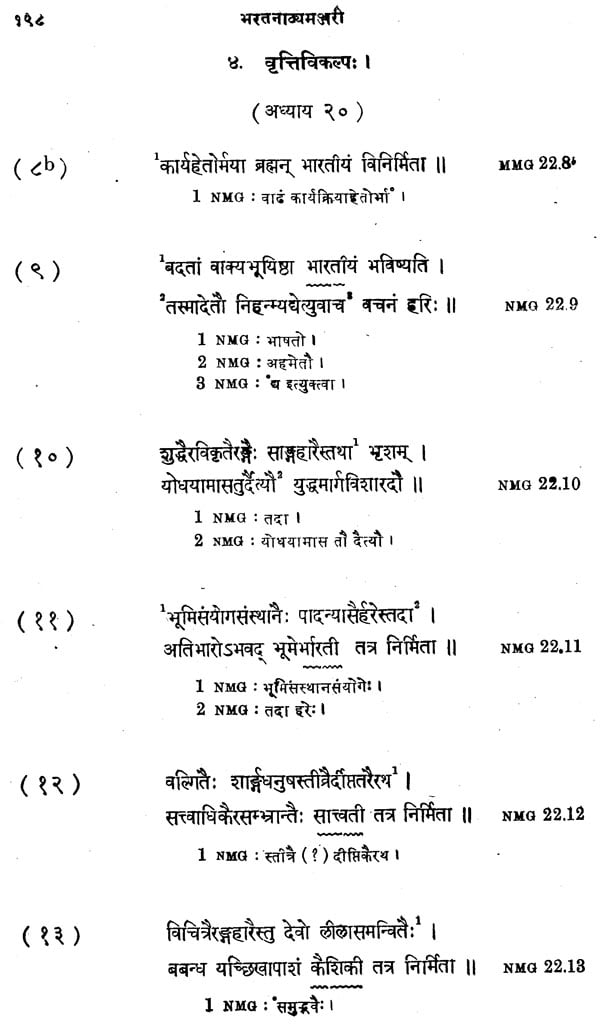
Bharat-Natya-Manjari (Bharata on the Theory and Practice of Drama)
Book Specification
| Item Code: | NAP804 |
| Author: | G.K. Bhat |
| Publisher: | Bhandarkar Oriental Research Institute, Pune |
| ISBN: | 9788194020035 |
| Pages: | 394 (9 B/W Illustrations) |
| Cover: | HARDCOVER |
| Other Details | 9.50 X 7.50 inch |
| Weight | 900 gm |
Book Description
Dr. G. K. BHAT joined the Bhandarkar Oriental Research Institute as Curator and Director of the Post- Graduate and Research Department on June 1. 1972. Ever since then he has occupied himself with several research schemes. big and small but it was the present one in which I had taken special interest from the very beginning. And this, for obvious reasons. I knew that Dr. BHAT had not only made a deep and perceptive study of Bharata's Natyasastra, but that, as a dramatist, actor and producer. he had also had occasions to relate Bharata's work to the modern theory and technique of drama. This had given quite a new dimension to his understanding of the subject. His present selections from Bharata's Natyasastra. accordingly, reflect great perspicacity and a new point of view. Having lectured on Sanskrit dramatic theory and practice both at Universities and Professional Workshops for many years, Dr. BHAT knows - almost instinctively- what students and professionals need to and ought to know from Bharata's basic text. The English translation, explanatory notes, and introduction, as also the artistically prepared drawings and photographs, have substantially enhanced the value of the book.
I have found the Bharata-Natya-Manjari fascinating and useful, and I feel sure that my judgments will be shared by many other readers.
Bharata's Natyasastra is a very big work and deals with music, dance. some aspects of poetics and rhetorics, prosody, the literary theory of drama and all the aspects of histrionics connected with the stage representation of drama. Later theoreticians borrow and use, with some variations, the precepts of Bharata, especially those relating to the composition and representation of drama. A student of Sanskrit drama generate turns to these later works for his information of Sanskrit dramatic theory and practice. I thought it desirable to collect the essential theoretical precepts of Bharata and present them topic-wise.
The Bharata-natya-mahjarl is such a selection which tries to present some essential details - not everything that Bharata has said concerning the theory and practice of Sanskrit drama. The selected verses are re-arranged in a different order, namely that of topical treatment. The text material presented here is derived from the four-volume Gaekwad Oriental Series Edition; the readings and text-reconstruction of Dr. GHOSH'S text are also included' for comparison and, sometimes, for elucidation. To facilitate first-hand study of the text-material, I have prepared a new English translation and added notes on technical and theoretical points.
The Introduction attempts to cover all aspects of Bharata's treatment of the subject, including even such topics as have not been included in the Selection or have been touched only briefly.
I hope that the presentation is comprehensive enough for an adequate knowledge about Bharata and as a base to evaluate the later theory and practice of Sanskrit drama. I have not added a separate bibliography, as the references are quoted fully in my notes to the Introduction. I propose to present, in a companion volume, the theoretical material on Sanskrit drama from later works.
I acknowledge with a deep sense of gratitude the debt I owe to the Bhandarkar Oriental Research Institute which has now become a second home to me and whose rich library has been at my disposal. I feel honoured that this work is being issued as a publication of the Institute. I am indebted to Dr. R. N. DANDEKAR for his continuous encouragement and personal kindness to me.
I have used for my own drawings a sketch of sad-daruka appearing in the GOS. ed. Vol. I, and another in Acarya Visvesvara's Hindi Abhinava bharatl, I am grateful to the Director, Oriental Research Institute, M. S. University, Baroda and to the Director, Department of Hindi, University of of Delhi, Delhi. (My drawings appear in my Introduction, on p, XLI ).
I must particularly thank Mrs. SUCHETA BHIDE-CHAPEKAR, the well- known exponent of Bharata-natyam, for kindly agreeing to pose for the photographs which I have presented here to illustrate some technical aspects of abhinaya.
I have also to thank Shri Sudhakar Khasagiwale B. A., G. D. (Art), for preparing the final drawings from my sketches of Bharata's theatre and stage and for doing the cover for this book.
The complete text of the Natyasastro of Bharata (NS.) first appeared in print as the Nirnayasagar edition, Bombay, in 1894. Another edition, varying in readings and numbering of verses, came as the Chowkhamba edition from Banaras in 1929. The text was published in the Gaekwad's Oriental Series (GOS.) in four volumes, from Baroda, from 192610 1954. The GOS edition was prepared after consulting nearly forty manuscripts and contains, besides, the valuable commentary of Abhinavagupta. Dr. Manomohan GHOSH made further researches and constituted the text, selecting readings from both the shorter and the longer versions, and with an arrangement of chapters. and verses slightly different from that of the GOS edition. This text of GHOSH was published with an English translation and a few textual notes from Calcutta in two parts in 1961 and 1967.
On the face of it, the text of the NS., as handed down to us, appears to be a composite one. The purana-like opening with a mongala verse and the presentation with Bharata expounding the natyaveda, created by Brahman and arranged properly by him, at the request of the sages who approached him to learn about it indicate an activity of compilation of the text. Inclusion of material other than what is called' the digest of natya repetition of verses and their misplacement in relation to the topic expounded, the adhyaya arrangement which is not always logical or consistent etc. are further indications that the present text may have been constituted at different periods of time and possibly by different hands. But if tradition looks upon the NS. as coming from a single author, Bharata, it has to be assumed that the aim in preparing the text was collection of all available material on dramaturgy and related topics, rather than its systematic editing and presentation, The present text of the NS. in thirty-six chapters contains the following elements :
( i ) Sutra-like statements and explanatory passages in prose, such as those connected with the theory of rasa and its constituents, music, and with , the meaning of abhinaya and pravrtti;
(ii) Auuvamsya slokas and Aryas (about 15 or 16);
(III) Several verses introduced with the words: sutranubaddhe Arya bhavatah ;
( iv) Verses simply introduced to confirm or elaborate a point : atra Slokah, atra arye: (about 100);
( v ) General text in verses, mostly in Anustubh and a few in Arya or Upajati metres ( about 5000 ).
There is a possibility that the original work was of the sUtra-v!'tli type, with a few karikas, as that is the oldest form of scientific writing known to ~s. The, text mentions the terms sangraha, sutra, karika, nirukta and explains them.' The objective may have been to provide a brief summary, a set of rules, of dramaturgy which could be useful to learners, actors and producers. The Nata-sutra which Papini mentions must have been a work of this nature: The sutranubaddha verses, according to Abhinava, are Bharata's own and they, are like karikas. , The anuvamsya slokas appear to be fixed verses handed', down in tradition. Bharata included them in the text to make it comprehensive but they probably do not belong to the original version. The other. verses in arya were composed by earlier teachers, according to Abhinava, and are included in the NS. text to elaborate, explain or confirm a point or precept. The general verses must have collected round the connected topics in the course of traditional expounding or may have been added to the text as the gradual growth of drama and the experience of its composition and production made more material available. It may not be possible to separate the various layers of material that must have gone into the compilation of the NS. text. But there does not, seem to be any doubt that it existed at least in two, short and long versions. ' This is supported by the old name of the work Natyaveda or Gandharvaveda which are used as synonyms in the tradition, and by the testimony of the commentators and their references to mula-karika, Sutrakara, Adi or Vrddha Bharata, and Bharata or Nandi-Bharata, Abhinava refers to the longer and shorter versions in his commentary. Saradanaya explicitly states that the natyaveda was composed' in 12,000 verses and abridged into 6,000 verses." However, in spite of the presumably gradual growth of the work and its" rather unsystematic arrangement of topics, the entire material is connected' to the unitary theme of dance and dramaturgy and tradition is satisfied to: look. upon it as the composition of a single author, Bharata.
But we are not in a position to be quite certain about who Bharata' really was. The account in the NS. places Bharata in the direct line of Brahmadeva, as one who received the .fifth veda ' from the creator-god!' Tradition looks upon him as a sage of great antiquity who presented his first' dramatic performance to an assembly of gods and asuras among whom Siva: was the chief referee and on whose advice and instruction Bharata added 'a: few significant details, like the Kaisiki mode, to his presentation," The sub-c sequent social degradation of Bharatas as a tribe of actors was, according to. legend, due to a curse.' To many students of the NS Bharata is a mythical legendary figure, symbolic like Vyasa or Manu. The NS. grew out of the original natyasutras by successive enlargements and additions taken from different sources; and to this compendium the name of Bharata as an author' was given in order to bestow prestige and authority on it for this purpose the mythical personality came quite handy. A modified opinion in this regard holds that Bharata wrote the core of the NS. and his disciples completed it. Alternatively, Bharata is supposed to be the first writer who systematized dramatic art. . These opinions verge towards regarding Bharata as a historical person. Dr. R1tGHAVAN thinks that he belongs to a Vedic trib.
**Contents and Sample Pages**

